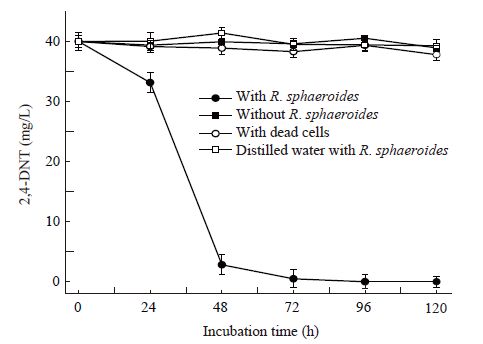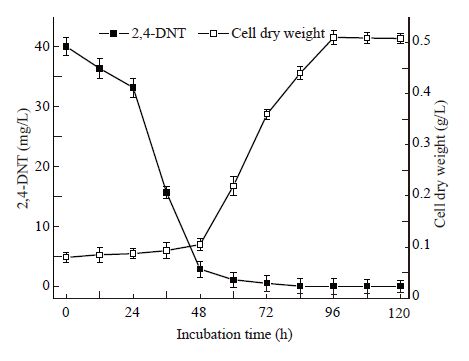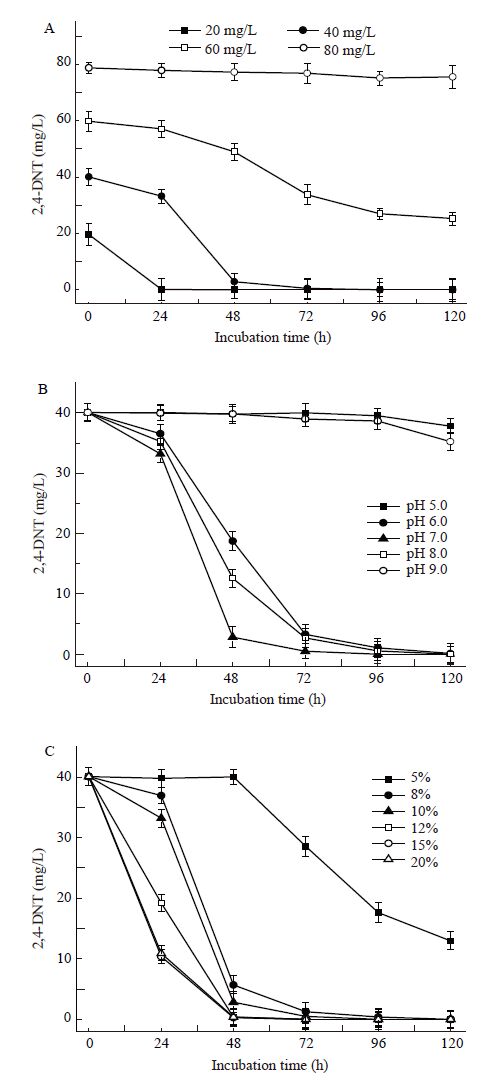扩展功能
文章信息
- 梁芳楠, 白红娟, 柴春镜, 王姗, 牛伟平, 赵婷婷
- LIANG Fang-Nan, BAI Hong-Juan, CHAI Chun-Jing, WANG Shan, NIU Wei-Ping, ZHAO Ting-Ting
- 球形红细菌厌氧降解2,4-二硝基甲苯
- Anaerobic biodegradation of 2,4-dinitrotoluene by Rhodobacter sphaeroides
- 微生物学通报, 2016, 43(2): 279-284
- Microbiology China, 2016, 43(2): 279-284
- 10.13344/j.microbiol.china.150346
-
文章历史
- 收稿日期: 2015-04-23
- 接受日期: 2015-06-16
- 优先数字出版日期(www.cnki.net): 2015-07-03
2. 中北大学朔州校区化工与环境学院 山西 朔州 036000;
3. 北京航天计量测试技术研究所 北京 100076;
4. 山西省农药检定所 山西 太原 030001
2. School of Chemical Engineering and Environment, North University of China,shuozhou, Shanxi 036000,China;
3. Beijing Aerospace Institute for Metrology and Measurement Technology,Beijing 100076,China;
4. Institute for the Control of Agrochemicals,Taiyuan,Shanxi 030001,China
2,4-Dinitrotoluene (2,4-DNT) is not only one of the most important explosives around active military firing ranges,but is also found as an intermediate compound in herbicides,dyes and synthetic foam industries[1]. The compound 2,4-DNT is ubiquitous and because of its high toxicity,carcinogenicity and mutagenicity to humans,2,4-DNT has been classified by the United States Environmental Protection Agency (US EPA) as a priority pollutant[2, 3].
To date,many studies reported the remediation of DNTs in contaminated sites. While biodegradation is expected to be an economical and energy efficient approach in comparison to other remediation processes such as chemical or physical ones[4]. Previous studies shown that several strains have the ability of degradation of 2,4-DNT,such as Pseudomonas[5],Alcaligenes[6],Burkholderia[7],Phanerochaete chrysosporium[8],Arthrobacter[9]. Researchers also found that microbial consortia can degrade 2,4-DNT by interspecies metabolism[10],poultry litter leachate[11] or different plant species[12]. However,there are two problems in these studies. First,these strains degrade 2,4-DNT only under strict anaerobic conditions or strict aerobic conditions. Second,the degradation time is long. Therefore,these factors limit their further application. Fortunately,the phototrophic bacteria can overcome those drawbacks. Phototrophic bacterium Rhodobacter sphaeroides,a typical purple non-sulfur bacterium,are metabolically the most versatile among all the procaryotes,can anaerobically photoautotrophic and photoheterotrophic in the light or aerobically chemoheterotrophic in the dark,so they can use a broad range of organic compounds as carbon and energy sources[13]. So far,there were no reports in the literature about degradation of 2,4-DNT by R. sphaeroides. The objectives of this study was to investigate the biodegradation of 2,4-DNT byR. sphaeroides.
2 Materials and methods 2.1 Microorganism and culture conditionsRhodobacter sphaeroides was obtained from College of Life Science and Technology,Shanxi University,Taiyuan,China. R. sphaeroides was cultured in the medium containing (in 1 L) 2.5 g malic sodium,0.2 g MgSO4×7 H2O,1 g yeast extract and 1.25 g (NH4)2SO4,the resulting medium was adjusted to pH 7.0 and then autoclaved[14]. The stock solution (1 800 mg/L) of 2,4-DNT in methanol was injected respective volume into sterilized serum bottles and allowed to evaporate methanol in the laminar hood under the airflow,then added into the medium without other carbon source (2,4-DNT as the sole carbon source). Unless otherwise stated,experiments were carried out in 45 ml serum bottles with a working volume of 45 ml. For use as inocula,the cells suspension was adjusted an OD590 of 1.0 using sterile fresh medium. After inoculation (10%,v/v),the serum bottles were sealed with rubber stoppers (R. sphaeroides is not a strict anerobe) and cultured anaerobically at 30 °C under continuous illumination with incandescent lamps at a light intensity of about 2 500 lx. Each test was carried out in triplicates.
2.2 Biodegradation experimentIn consideration of abiotic 2,4-DNT degradation,control experiments were conducted with 40 mg/L of 2,4-DNT with R. sphaeroides or without R. sphaeroides. At the same time,media inoculated with dead cells were used as control by autoclaving at 1×105 Pa for 30 min. In addition,R. sphaeroides with distilled water containing 2,4-DNT (40 mg/L) was also prepared.
To further investigate the biodegradation capability of 2,4-DNT by R. sphaeroides,the effects of other operating parameters on the removal of 2,4-DNT were conducted in incubator under 30 °C. Various conditions can be described briefly as illumination and oxygen (anaerobic and illumination,anaerobic and dark,microaerobic and illumination,aerobic and dark),initial concentration (20,40,60,80 mg/L),initial pH value (5.0,6.0,7.0,8.0,9.0),and inoculation quantity (5%,8%,10%,12%,15%,20%). For each batch experiment,one of the parameters was changed while the others kept constant. At regular intervals,10 mL samples were collected from each bottle and centrifuged at 8 000×g for 20 min. The concentration of 2,4-DNT in the supernatant was determined by HPLC. The cells were washed and re-suspended with equivalentdistilled water,then the biomass was monitored by OD590. To obtain the intracellular 2,4-DNT fraction,cells was collected after the biomass was monitored,and subsequently kept in an ice bath during the cell disruption to prevent overheating. Cell disruption was performed at 650 W for 5 min (5 s: 10 s pulse on: off basis),then centrifuged at 15 000×g for 30 min[15].
In addition,the removal rate constant (k) and half-life removal time (t1/2=0.693/k) were measured using a first-order kinetic equation,C=C0e-kt,where C is the 2,4-DNT concentration at time t (mg/L),C0 is the initial concentration (mg/L),k is the removal rate constant (h−1) and t is the time (h).
2.3 Analytical methods2,4-DNT was analyzed using a Ultimate 3000 HPLC (USA)equipped with a UV-visible detector. The separation column used for HPLC was C18 reverse-phase column (250 mm × 4.6 mm inner diameter: 5 μm particle size) at 20 °C. The mobile phase was methanol/water(70:30,v/v),with a flow rate of 0.9 mL/min. The wavelength used for detection was 254 nm,and the injection volume was 20 μL.
3 Results 3.1 Degradation of 2,4-DNT in control experimentsAs shown in Figure1,2,4-DNT was almost completely removed by R. sphaeroides within 72 h. However,under the condition of without R. sphaeroides orwith dead cells or R. sphaeroides with distilled water,there was no significant change in the 2,4-DNT levels,and the concentration of 2,4-DNT was stable at about 39 mg/L over the whole incubations of 120 h. The results of the control experiments were in good agreement with other previous work,volatilization and adsorption were insignificant factors[16]. Fate of 2,4-DNT with R.sphaeroides was mainly due to biological process.

|
| 图1 在pH 7.0、30 °C时球形红细菌对40 mg/L 2,4-DNT的去除 Figure 1 The removal of 40 mg/L 2,4-DNT by R. sphaeroides at pH 7.0 and 30 °C |
Figure2 shows that the strain inoculated from 0 h to approximately 48 h was in a lag phase,and the concentration of 2,4-DNT decreased sharply from 24 h to 48 h. The removal rate of 2,4-DNT achieved 92.9% at 48 h. In addition,the concentration of 2,4-DNT in the intracellular fraction incubated for 24 h and 48 h was 6.1 mg/L and 32.8 mg/L,respectively. Moreover,two different intermediates derived from 2,4-DNT were detected in the medium at 48 h,and reached the maximum at 72 h,then gradually disappeared within 120 h (Figure3). The result indicates that 2,4-DNT is absorbed by the cells of the strain in lag phase,then degraded as carbon source in exponential phase.

|
| 图2 球形红细菌生长和去除40 mg/L 2,4-DNT的曲线 Figure 2 The curves of 40 mg/L 2,4-DNT removal and the R. sphaeroides growth |

|
| 图3 球形红细菌降解40 mg/L 2,4-DNT时出现中间产物的高效液相色谱图 Figure 3 HPLC profiles for intermediate metabolites produced from 40 mg/L 2,4-DNT biodegradation by R. sphaeroides at different time |
Table1 shows that R. sphaeroides can biodegradation 2,4-DNT in various conditions. The optimum condition was anaerobic and illumination,the removal rate of 2,4-DNT was reached 98.8% at 72 h. The results proved the property of R. sphaeroides that the strain can change the metabolism flexibly according to environmental conditions[17]. Hence,we chose anaerobic biodegradation of 2,4-DNT by R. sphaeroides in subsequent experiments.
| Illumination and oxygen | Dry cell weight (g/L) | Degradation efficiency (%) |
| Anaerobic and illumination | 0.36 | 98.8 |
| Anaerobic and dark | 0.20 | 86.5 |
| Microaerobic and illumination | 0.29 | 90.6 |
| Aerobic and dark | 0.16 | 80.7 |
| Note: Effect of illumination and oxygen on R. sphaeroides growth and the removal of 2,4-DNT were conducted at initial concentration of 40 mg/L,pH 7.0,inoculation quantity of 10% at 30 °C for 72 h. 注:在30 °C、pH 7.0、接种量10%时,72 h不同光照供氧对R. sphaeroides生长和40 mg/L 2,4-DNT去除的影响. | ||
As the initial concentration of 2,4-DNTincreased from 20 mg/L to 80 mg/L,the removal rates at 72 h were 100%,98.8%,43.6% and 2.43%,respectively (Figure4A). The higher levels may inhibit the growth and metabolic activity of microorganisms,thus further suppress the biodegradation of 2,4-DNT[18].

|
| 图4 初始浓度(A)、初始pH (B)和接种量(C)对2,4-DNT去除的影响 Figure 4 The effect of initial concentration of 2,4-DNT (A),initial pH (B),and inoculation quantity (C) on the removal of 2,4-DNT in batch culture |
Figure4B shows thatthe highest 2,4-DNT consumption occurred at initial pH 7.0,and more than 91.8% of 2,4-DNT was degraded when the initial pH of the culture medium ranged from 6.0 to 8.0 within 72 h. However,removal rate significantly declined at initial pH 5.0 or initial pH 9.0. The result agrees well with several reports that the optimal initial pH range for the growth of anaerobic microorganisms is between 6.0 and 8.0[19].
3.5 Effect of inoculation quantityThe trend of degradation rate of 2,4-DNT in Figure4C revealed that the degradation time was shorten with the increase of inoculation quantity from 8% to 15%[20]. However,when inoculation quantity increased to 20%,there was no significant change for the degradation rate of 2,4-DNT. The result illustrates that the inoculation quantity of 15% is enough to meet the requirements of the degradation of 2,4-DNT. In addition,considering the economic factors,the optimum inoculation quantity is 15%.
3.6 Biodegradation kinetics of 2,4-DNTTable2 shows that the removal of 2,4-DNT follows first-order kinetic reaction. With initial concentrations increase steadily from 20 to 80 mg/L,the removal rate constants decreasequickly from 0.206 9 to 0.000 4 h−1,while the half-life increasedfrom 3.4 to 1 732 h. The removal rate constants andhalf-life of inoculation quantity exhibited the opposite changing tendency to the initial concentrations (Table3). The shift of inoculation quantity from 5% to 15% can significantly enhance the removal rate of 2,4-DNT by R. sphaeroides. Similarly,as Table4 shows,with the initial pH values increased from 5.0 to 7.0 then to 9.0,the rate constants increased from 0.000 1 to 0.059 3 h−1 and finally dropped to 0.000 4 h−1. Nevertheless,there is an opposite trend for the half-life,which drop steeply from 6 930 h to 11.7 h as the initial pH value jumped from 5.0 to 7.0,and then went up to 1 732 h with further rose initial pH to 9.0[21]. Thus,the maximum removal rates of 2,4-DNT and optimum specific bacterial growth are obtained near initial pH 7.0 and inoculation quantity of 15%,which agreed well with our experimental results described above.
| Initial concentration (mg/L) | k (h−1) | T1/2 (h) | R2 | C=C0e-kt |
| 20 | 0.206 9 | 3.4 | 0.964 0 | C=19.59e-0.206 9t |
| 40 | 0.059 3 | 11.7 | 0.994 1 | C=40.08e-0.059 3t |
| 60 | 0.007 3 | 94.9 | 0.929 7 | C=59.76e-0.007 3t |
| 80 | 0.000 4 | 1 732 | 0.921 8 | C=78.71e-0.000 4t |
| Inoculation quantity (%) | k (h-1) | T1/2 (h) | R2 |
| 5 | 0.008 3 | 83.5 | 0.887 4 |
| 8 | 0.045 9 | 15.1 | 0.929 4 |
| 10 | 0.059 3 | 11.7 | 0.994 1 |
| 12 | 0.084 2 | 8.2 | 0.837 5 |
| 15 | 0.093 4 | 7.4 | 0.923 9 |
| 20 | 0.087 6 | 7.9 | 0.928 9 |
| Initial pH value | k (h-1) | T1/2 (h) | R2 |
| 5.0 | 0.000 1 | 6 930 | 0.931 4 |
| 6.0 | 0.044 3 | 15.6 | 0.963 5 |
| 7.0 | 0.059 3 | 11.7 | 0.994 1 |
| 8.0 | 0.038 6 | 17.9 | 0.889 4 |
| 9.0 | 0.000 4 | 1 732 | 0.999 7 |
This is the first study to report the biodegradation of 2,4-DNTusing R. sphaeroides. The strain was able to grow in medium with 2,4-DNT as sole carbon source. Notably,2,4-DNT was removed through biological processes. The optimum reaction conditions were initial concentration of 40 mg/L,initial pH 7.0,and inoculation quantity of 15%. In addition,2,4-DNT could be absorbed by the cells in lag phase,then degraded as carbon source in exponential phase,the removal rate of 2,4-DNT achieved 98.8% at 72 h. Moreover,two different intermediate metabolites detected as a result of biodegradation of 2,4-DNT. Further studies areneeded to identify the metabolites by GC-MS,then reveal the anaerobic 2,4-DNT degrading pathway under photoheterotrophic growth conditions by R. sphaeroides.
AcknowledgementsWe thank Dr. Vincent from National Research Centre for Environmental Toxicology (Entox),the University of Queensland Australia for revising the manuscript. Also,we thank Professor Jiao Weizhou and Feng Zhirong from Research Center of Shanxi Province for High Gravity Chemical Engineering and Technology,North University of China for technical support in carrying out the experiments.
| [1] | Spain JC. Biodegradation of nitroaromatic compounds[J]. Annual review of microbiology,1995,49: 523-555 |
| [2] | Rickert DE,Butterworth BE,Popp JA,et al. Dinitrotoluene: acute toxicity,oncogenicity,genotoxicity,and metabolism[J]. Critical Reviews in Toxicology,1984,13(3): 217-234 |
| [3] | Keither LH,Telliard WA. Priority pollutants: I-a perspective view[J]. Environmental Science & Technology,1979,13(4): 416-423 |
| [4] | Dou J,Liu X,Ding A. Anaerobic degradation of naphthalene by the mixed bacteria under nitrate reducing conditions[J]. Journal of Hazardous Materials,2009,165(1/3): 325-331 |
| [5] | Spanggord RJ,Spain JC,Nishino SF,et al. Biodegradation of 2,4-dinitrotoluene by a Pseudomonassp.[J]. Applied and environmental microbiology,1991,57(11): 3200-3205 |
| [6] | Smets BF,Mueller RJ. Metabolism of 2,4-dinitrotoluene (2,4-DNT) by Alcaligenes sp. JS867 under oxygen limited conditions[J]. Biodegradation,2001,12(4): 209-217 |
| [7] | Nishino SF,Spain JC,Lenke H,et al. Mineralization of 2,4- and 2,6-dinitrotoluene in soil slurries[J]. Environmental Science & Technology,1999,33(7): 1060-1064 |
| [8] | Valli K,Brock BJ,Joshi DK,et al. Degradation of 2,4-dinitrotoluene by the lignin-degradingfungus Phanerochaete chrysosporium[J]. Applied and environmental microbiology,1992,58(1): 221-228 |
| [9] | Küce P,Coral G,Kantar Ç. Biodegradation of 2,4-dinitrotoluene (DNT) by Arthrobacter sp. K1 isolated from a crude oil contaminated soil[J]. Annals of Microbiology,2015,65(1): 467-476 |
| [10] | Snellinx Z,Taghavi S,Vangronsveld J,et al. Microbial consortia that degrade 2,4-DNT by interspecies metabolism: isolation and characterisation[J]. Biodegradation,2003,14(1): 19-29 |
| [11] | Gupta G,Bhaskaran H,Kananen G,et al. Biodegradation of 2,4-dinitrotoluene using poultry litter leachate[J]. Journal of Hazardous Materials,2004,113(1/3): 137-140 |
| [12] | Podlipná R,Pospíšilová B,Vaněk T. Biodegradation of 2,4-dinitrotoluene by different plant species[J]. Ecotoxicology and Environmental Safety,2015,112: 54-59 |
| [13] | Kim MK,Choi KM,Yin CR,et al. Odorous swine wastewater treatment by purple non-sulfur bacteria,Rhodopseudomonas palustris,isolated from eutrophicated ponds[J]. Biotechnology Letters,2004,26(10): 819-822 |
| [14] | Yao ZY,Zhang ZM. Phenotypic features and DNA-DNA homology analyses of some photosynthetic bacteria[J]. Chinese Journal of Applied and Environmental Biology,1996,2(1): 84-89 (in Chinese) 姚竹云,张肇铭. 几株光合细菌的表型特征及DNA-DNA同源性分析[J]. 应用与环境生物学报,1996,2(1): 84-89 |
| [15] | Ye JS,Yin H,Peng H,et al. Biosorption and biodegradation of triphenyltin by Brevibacillus brevis[J]. Bioresource Technology,2013,129(2): 236-241 |
| [16] | Christopher HJ,Boardman GD,Freedman DL. Aerobic biological treatment of 2,4-dinitrotoluene in munitions plant wastewater[J]. Water Research,2000,34(5): 1595-1603 |
| [17] | Hu XM,Dong YH,Li L,et al. Biodegradation Characteristics of o-chlorophenol with photosynthetic bacteria PSB-1D[J]. Environmental Science,2010,31(7): 1672-1678 (in Chinese) 胡筱敏,董怡华,李亮,等. 光合细菌PSB-1D对2-氯苯酚的降解特性研究[J]. 环境科学,2010,31(7): 1672-1678 |
| [18] | Hong HB,Nam IH,Kim YM,et al. Effect of heavy metals on the biodegradation of dibenzofuran in liquid medium[J]. Journal of Hazardous Materials,2007,140(1/2): 145-148 |
| [19] | Chang BV,Chang SW,Yuan SY. Anaerobic degradation of polycyclic aromatic hydrocarbons in sludge[J]. Advances in Environmental Research,2003,7(3): 623-628 |
| [20] | Chen SJ,Alexander M. Reasons for the acclimation of 2,4-D biodegradation in lake water[J]. Journal of Environmental Quality,1989,18(2): 153-156 |
| [21] | Liang ZS,An TC,Li GY,et al. Aerobic biodegradation of odorous dimethyl disulfide in aqueous medium by isolated Bacillus cereus GIGAN2 and identification of transformation intermediates[J]. Bioresource Technology,2015,175: 563-568 |
 2016, Vol. 43
2016, Vol. 43




